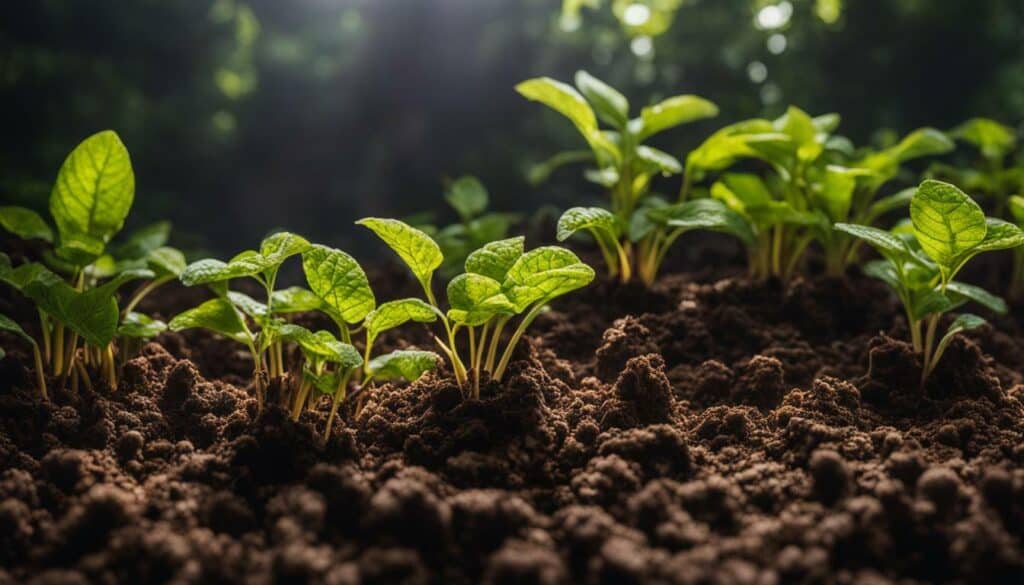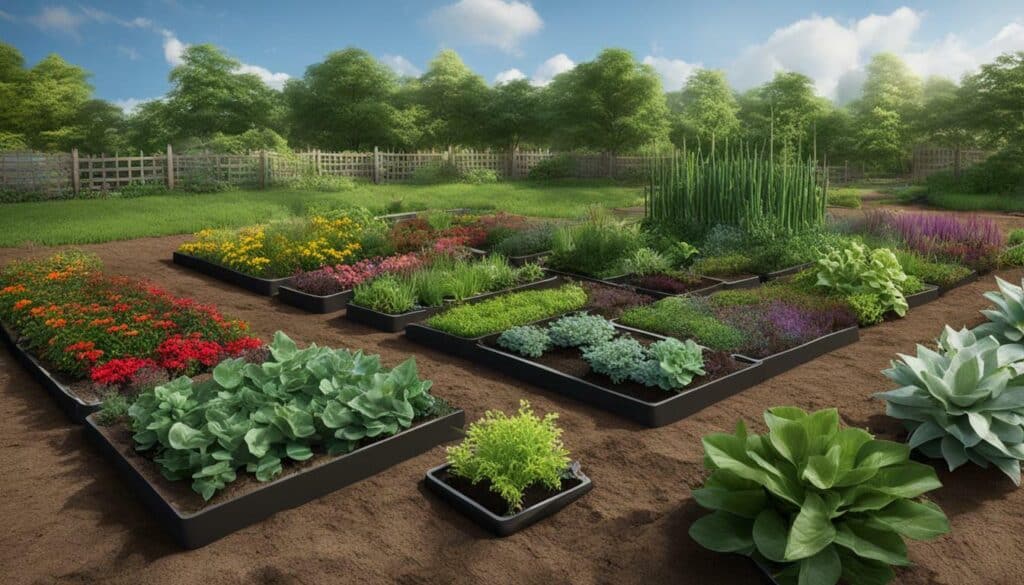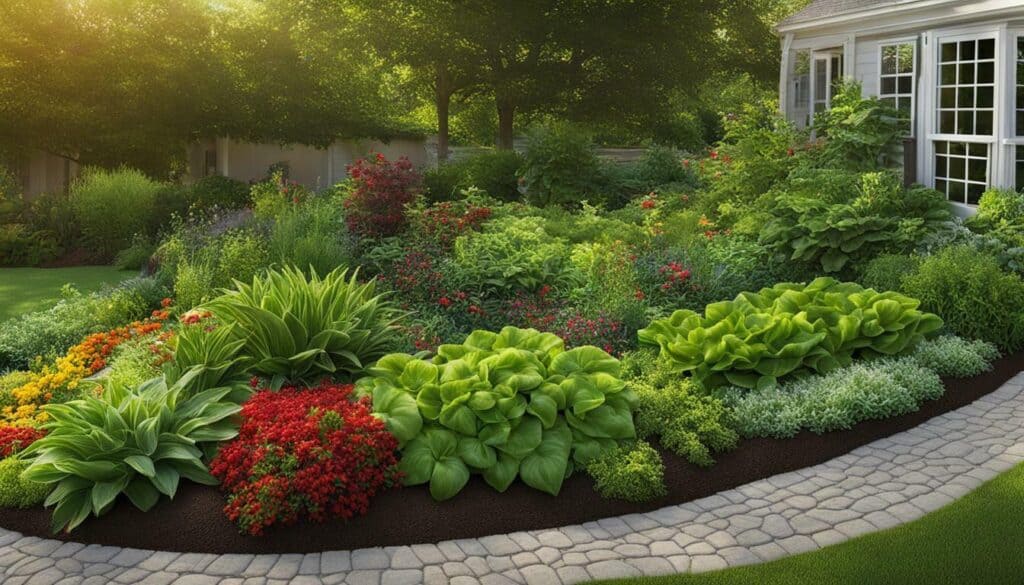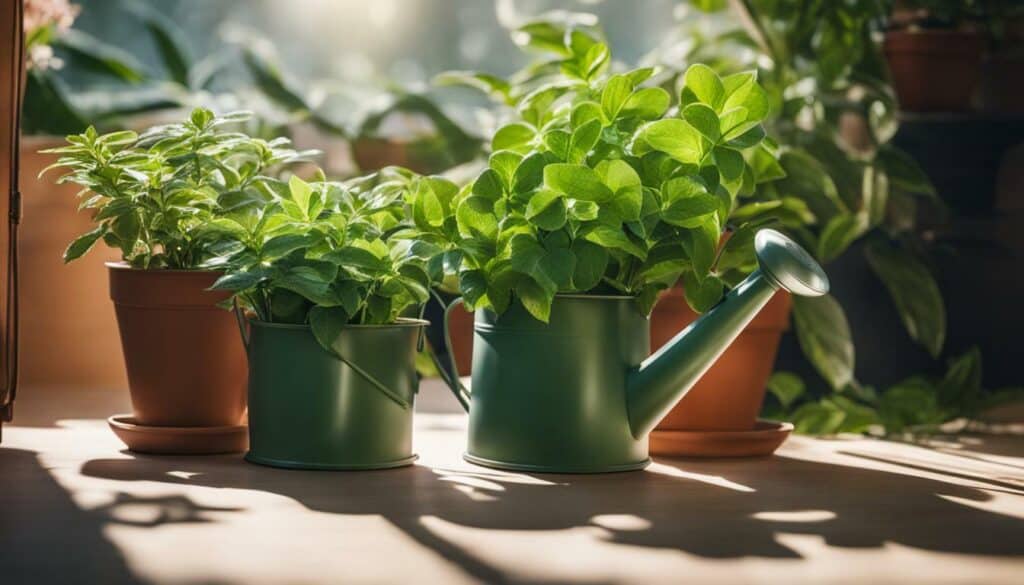Starting a garden can be overwhelming, but it doesn’t have to be. Here are some tips for success:
Choosing the right location and ensuring ample sunlight exposure are crucial for growing healthy plants. Raised garden beds can help with drainage and prevent flooding risks in areas with heavy rainfall. With so many types of plants to choose from, it’s important to understand your gardening zone and select plants that will thrive in your climate. To maintain healthy soil, add mulch and avoid tilling, which can disrupt the soil ecosystem.
Observing your plants daily and addressing any issues promptly will prevent pests, overcrowding, and nutrient deficiencies. Spending time with your plants and caring for them can make a huge difference in their health and productivity, so don’t be afraid to get your hands dirty.
Key Takeaways:
- Choose a location with ample sunlight and consider using raised garden beds.
- Select plants suitable for your gardening zone and climate.
- Build and maintain healthy soil by adding mulch and avoiding tilling.
- Regularly observe and care for your plants to prevent and address issues.
Choosing the Right Location and Sunlight Exposure
When it comes to gardening success, choosing the right location and ensuring proper sunlight exposure are key. It’s important to consider factors such as the amount of rainfall and the terrain of the land when starting a garden. Low areas that are prone to flooding may require raised beds, while drier areas may be suitable for in-ground gardens.
The direction in which a hillside faces is also important, as a north-facing hill will receive less sunlight than a south-facing hill. Most vegetable plants require a minimum of six to eight hours of sunlight per day, so it is crucial to choose a location that receives adequate sunlight. Take note of the areas in the garden that receive sunlight and those that are shaded at different times of the day.
The shape of the garden can also affect sunlight exposure, with rectangular beds running north and south being ideal. If location is a concern, container gardening provides the flexibility to move plants into the sun or shade as needed. Starting small and expanding as one learns more about gardening is recommended.
| Flooding risks | Drainage | Shade |
|---|---|---|
| In areas prone to flooding, raised beds can provide a solution for growing vegetables and flowers. | Good drainage is important for healthy roots and plants. If the soil is heavy or clay-like, adding organic matter can improve drainage. | Some plants, such as lettuce and spinach, prefer shade. When choosing a location, consider the amount of shade the area receives throughout the day. |
In addition to location and sunlight, maintaining healthy soil is also crucial for successful gardening. Mulching the garden bed helps keep the soil cool and moist, reduces the need for watering and weeding, and maintains the soil’s natural ecosystem.

Knowing one’s gardening zone is also important. This helps in choosing plants that are suited for the specific climate and temperature range. Understanding frost dates is also key, as warm-season plants can be damaged by frosts. By following these tips and caring for plants on a daily basis, gardeners can increase their chances of gardening success.
Building and Maintaining Healthy Soil
Creating and maintaining healthy soil is crucial for a thriving garden. As a gardener, it is important to understand the soil ecosystem and avoid tilling the soil as it disrupts the natural balance of nutrients and organisms. Instead, consider mulching the garden bed with materials like shredded leaves, grass clippings, or straw. Mulching helps retain moisture, deters weeds, and maintains soil life.
Choosing the right location for your garden bed is also essential. Factors to consider include drainage, sunlight exposure, and potential obstructions. A garden bed in a cool and moist location is ideal for many plants.
It’s important to note your gardening zone and frost dates, which can help you select plants that are suitable for your area. Understanding these dates is critical for planting delicate, warm-season crops that are at risk of exposure to frost. The last frost date is the date on which you can safely plant warm-season crops, while the first frost date signifies when it’s time to harvest and protect plants that are susceptible to frost damage.
Observing your plants daily, checking for pests, ensuring adequate water and fertilization, and addressing issues promptly are crucial for maintaining healthy plants. Putting in the love and care for your garden will determine your gardening success.

Understanding Your Gardening Zone
Understanding your gardening zone is essential for selecting the right plants and ensuring gardening success. Your gardening zone is determined by the average lowest temperatures in your area, which affect the types of plants that can thrive. Plants that are not suited to your specific zone may struggle to grow, or even die off completely, which can be frustrating and costly.
Fortunately, the United States Department of Agriculture (USDA) has created a map of the country that shows the different gardening zones based on temperature. You can use this map to determine your gardening zone and choose plants that are suited to your specific climate.
| Gardening Zone | Average Minimum Temperature | Example Plants |
|---|---|---|
| Zones 1-2 | -60°F to -50°F | Arctic poppy, Iceberg lettuce |
| Zones 3-4 | -50°F to -30°F | Carrots, Peaches |
| Zones 5-6 | -30°F to -10°F | Tomatoes, Pumpkins |
| Zones 7-8 | -10°F to 10°F | Blueberries, Citrus trees |
| Zones 9-10 | 10°F to 40°F | Bananas, Mangoes |
It is also important to know your frost dates, or the average dates of the last and first frosts in your area. This information is important as it allows you to plant warm-season crops like tomatoes and peppers at the appropriate time, ensuring that they are not exposed to frost and have the best chance of thriving.
When it comes to selecting plants for your garden, always choose plants that are suited to your gardening zone and your specific climate. This will give you the best chance of success and ensure that your garden flourishes throughout the growing season.

Knowing Your Frost Dates
Being aware of your frost dates can make a significant difference in the success of your garden. Frost dates indicate the start and end of the growing season and help determine when to plant warm-season crops like tomatoes, peppers, and cucumbers.
The last frost date is the final day of spring when frost is expected, and after this date, it is considered safe to plant warm-season crops outdoors. Similarly, the first frost date is the date in fall when frost is typically expected, and it marks the end of the growing season for warm-season crops. It’s important to note that warm-season plants cannot tolerate frost and will die if exposed to it.
To find the frost dates for your area, check out resources like the Old Farmer’s Almanac site or USDA Plant Hardiness Zone Map. Understanding your gardening zone is also important since certain plants thrive better in specific zones.

Once you know your frost dates, you can plan your garden accordingly. If you live in an area with a short growing season, you may need to start your warm-season plants indoors earlier, so they have time to mature before transplanting them outside. Similarly, if you live in an area with a long growing season, you may have multiple opportunities to plant and harvest crops throughout the season.
Remember, caring for your plants and observing them daily is essential for gardening success. Taking the time to check on their health, watering and fertilizing them, as well as addressing any pest or weed issues, can ensure that your plants thrive. The key to gardening success lies in your love and care for your plants, as well as continuously learning and experimenting in your garden.
Taking Care of Your Plants
Caring for your plants is vital for their overall health and productivity. Observing your plants on a daily basis is important to identify any signs of stress or pest infestation. Overcrowding can lead to stunted growth and disease, so it’s important to space your plants appropriately.
Pests are one of the biggest challenges when it comes to plant care. Be on the lookout for common pests like aphids, mites, and caterpillars. Keep your garden clean and tidy to prevent pests from setting up camp.
Nutrient deficiencies can also be a problem. If you notice yellowing leaves or poor growth, your plants may be lacking in key nutrients. Adding compost or organic fertilizers can provide your plants with the nutrients they need to thrive.
Prevention is key when it comes to caring for your plants. Regularly inspect your plants for signs of stress or pest infestation, and take immediate action to address any issues. By being proactive, you can catch problems early before they become major issues.

Taking care of your plants requires consistent effort and attention, but the rewards are well worth it. Don’t be discouraged by failures; instead, use them as a learning opportunity to improve your gardening skills. With patience, dedication, and a love for gardening, you can achieve great results in your garden.
Conclusion
In summary, successful gardening involves choosing the right location and sunlight exposure, maintaining healthy soil, understanding your gardening zone and frost dates, and caring for your plants regularly. By paying attention to these key factors, you can establish a strong foundation for a thriving garden.
Remember, gardening is a process that requires patience, care, and time. It’s important to observe your plants regularly and address any issues promptly to prevent pests, overcrowding, nutrient deficiencies, and other problems. Learning from failures and persevering through challenges is essential to improving your gardening skills and achieving success.
So, whether you’re a seasoned gardener or just starting out, don’t be afraid to start small and work your way up. With dedication and persistence, you can create a beautiful and productive garden that brings joy and satisfaction for years to come.
Thank you for reading and happy gardening!
FAQ
Q: What are the most important factors to consider when choosing a location for my garden bed?
A: It’s important to choose a location that receives at least six to eight hours of sunlight per day and consider factors like drainage, flooding risks, and shade from trees or buildings.
Q: How can I build and maintain healthy soil in my garden?
A: Avoid tilling the soil, as it disrupts the natural ecosystem. Instead, mulch the garden bed to keep the soil cool and moist, deter weeds, and maintain soil life. You can use shredded leaves, grass clippings, or straw as mulch.
Q: Why is it important to know my gardening zone?
A: Knowing your gardening zone helps you choose plants that are suited to your climate. Different plants thrive better in certain zones, so researching your specific zone will increase your chances of gardening success.
Q: How do frost dates affect planting and harvesting?
A: Frost dates are important because warm-season plants can die if exposed to frost. Knowing the average last frost date in the spring and the first frost date in the fall for your area will help you determine the right timing for planting and harvesting certain crops.
Q: What should I do to take care of my plants?
A: Take time to observe your plants daily and check for signs of pests, overcrowding, or nutrient deficiencies. Act quickly to address any problems and take steps to prevent them from happening in the first place. Spend time with your plants and give them the care and attention they need.
How Can Your Gardening Yard Tips Help Improve Garden Success?
Are you looking to enhance your garden’s success? Look no further than these essential gardening yard tips. With proper care and attention, your yard can become a haven for beautiful plants and a flourishing ecosystem. From selecting the right soil and fertilizers to employing smart watering techniques, these gardening yard tips will empower you to create a healthy and thriving garden.
Source Links
- https://donotdisturbgardening.com/tips-for-having-a-successful-garden-beginners-and-experts/
- https://www.homemadefoodjunkie.com/9-tips-for-gardening-success/
- https://youshouldgrow.com/successful-garden/
- https://www.burpeehomegardens.com/gardenhelp/GardenSuccess/
- https://www.almanac.com/10-tips-beginner-gardeners
- https://www.growingagreenerworld.com/tips-for-growing-the-perfect-vegetable-garden/
- https://sebsnjaesnews.rutgers.edu/2020/04/choosing-the-right-location-for-your-vegetable-garden/
- https://www.almanac.com/where-put-vegetable-garden
- https://www.hgtv.com/outdoors/gardens/planting-and-maintenance/garden-exposure-choosing-the-right-site-for-your-plants
- https://themicrogardener.com/5-simple-secrets-to-building-healthy-soil/
- https://extension.psu.edu/practical-tips-for-healthy-soil-in-a-home-garden
- https://www.gardeners.com/how-to/building-healthy-soil/5060.html
- https://www.gardeningknowhow.com/planting-zones/what-do-hardiness-zones-mean.htm
- https://www.bhg.com/gardening/gardening-by-region/how-to-use-hardiness-zone-information/
- https://www.cnet.com/home/yard-and-outdoors/understanding-your-usda-hardiness-zone-and-why-itll-keep-your-plants-alive/
- https://www.gardensafe.com/tips/diy-gardening/understanding-frost-dates.aspx
- https://www.almanac.com/gardening/frostdates
- https://www.marthastewart.com/8301730/what-is-first-last-frost-date
- https://www.allthatgrows.in/blogs/posts/plant-care-tips
- https://www.wikihow.com/Take-Care-of-Plants
- https://www.insider.com/how-to-take-care-of-plants-2018-7
- https://growingourown.wordpress.com/6-conclusion/
- https://www.daleharvey.com/in-the-garden/articles-of-interest/PACIFIC STEEL SUTTON PARK/Sutton Park Primary School Gardening Project/Page 5 – Conclusion.html
- https://www.betterhealth.vic.gov.au/health/healthyliving/gardening-for-children





Leave a Reply